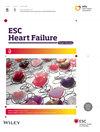The use of echocardiography and echocardiographic findings in patients hospitalized for acute heart failure
Abstract
Aims
Transthoracic echocardiography (TTE) is recommended as a key investigation in patients with acute heart failure (AHF) in major guidelines. However, utilization and benefits are yet to be known in Thai patients. The study aims to evaluate the benefits of TTE and identify factors associated with the decision to perform TTE on patients with AHF.
Methods
This is a retrospective study of consecutive patients hospitalized for AHF in a tertiary care hospital in Thailand from July 2017 to June 2019. The patients were identified by the International Classification of Diseases (ICD) coding, and the diagnosis of AHF was confirmed by the Framingham criteria. Characteristics and outcomes of the patients who received TTE and those who did not were compared. Factors determining the use of TTE during hospitalization were identified using regression analysis.
Results
A total of 697 patients were enrolled (mean age 69 ± 14.6 years, 50.5% women, mean ejection fraction 47 ± 18.9%). Of these, 362 patients (51.9%) had TTE during hospitalization. The mean age and comorbidities were similar between groups. The patients with TTE were more likely to be women (54.6% vs. 46.1%, P = 0.03). More severe hospital courses were observed in patients with TTE, including intensive care unit (ICU) admission, mechanical ventilation and inotrope use (26.5% vs. 10.7%, 26.2% vs. 14.9%, and 24% vs. 13.1%, respectively; P < 0.001 for all). The overall in-hospital mortality was 5.5% and not different between groups. The 30 day mortality was lower in patients with TTE but did not reach statistical significance (2.1% vs. 4.7%, P = 0.05). In multivariate analysis, patients with ICU admission [adjusted odds ratio (aOR) = 7.33], longer length of stay (aOR = 3.05), higher haemoglobin (aOR = 1.22) and lower blood urea nitrogen (BUN) level (aOR = 1.37) were independent factors associated with the decision to perform TTE on patients hospitalized for AHF (P < 0.05 for all).
Conclusions
TTE was commonly performed in patients hospitalized for AHF, especially ones with more severe hospital courses. The outcomes were not different in patients who received TTE.


 求助内容:
求助内容: 应助结果提醒方式:
应助结果提醒方式:


